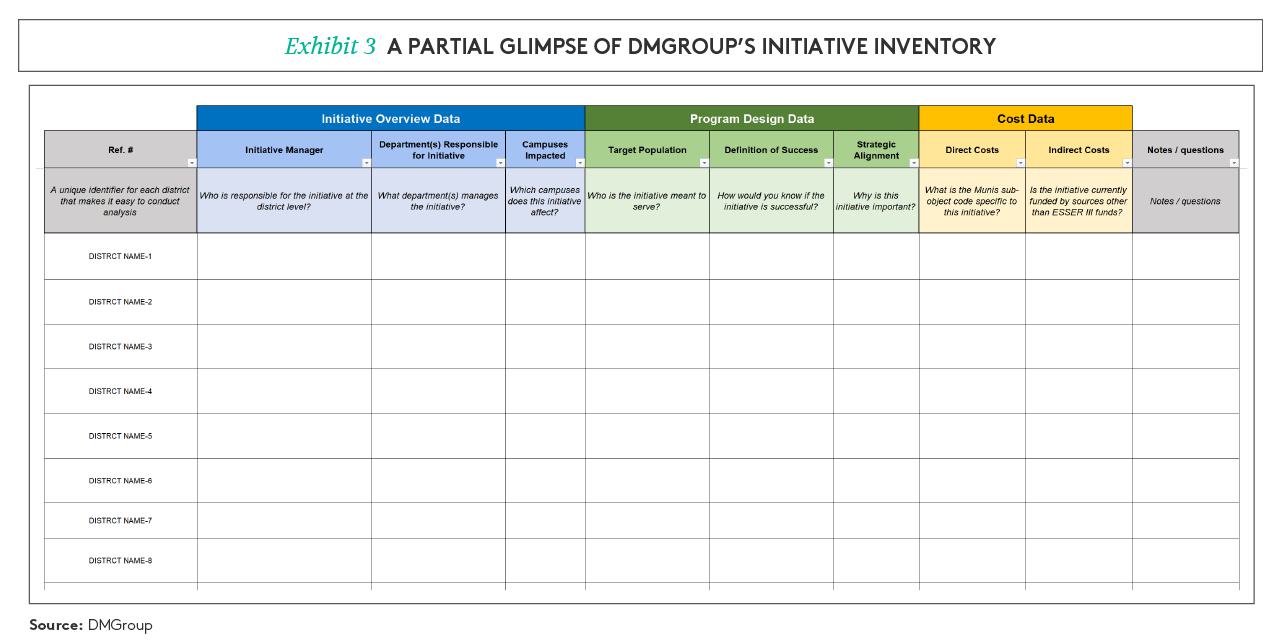Warnings abound about bracing for the looming fiscal cliff after the unprecedented nearly $190 billion in federal funding for the sector. However, the current environment of rising interest rates, recession threats, and turmoil related to the implosion of Silicon Valley Bank and First Republic augur significant additional fiscal challenges. If history is our guide, the public education sector has a couple years before it will feel the effects of the current economic situation (Exhibit 1). But these challenges will likely be significant, including lower local tax revenues, increased borrowing costs, and even greater student needs with more families falling below the poverty level.

A simultaneous fiscal cliff and fiscal threats seem ominous, but districts do have time to prepare. The challenge is to take action now to ensure that all their resources can be deployed for maximum impact.
To start, district leaders must first get their arms around all the programs and initiatives currently being offered around the district. Secondly, district leadership need to understand which programs/initiatives deliver results, for which student groups, and at what cost. Finally, the district can use this information to determine how to allocate resources and do so with greater sophistication - expanding successful programs, tailoring and targeting programs for specific groups of students, and eliminating programs that do not deliver expected results. This is strategic budgeting – ensuring resources are directed effectively and efficiently to maximize student outcomes and achieve the district’s strategic priorities.
DMGroup’s Strategic Budgeting Approach
Despite collecting a voluminous amount of data required by local, state, and federal regulations, school districts often lack systems, structures, training, and resources to translate this compliance-driven data into actionable management information that can be used for better decision-making. In many cases, decisions about program funding are determined by the strongest, most vocal constituents. Moreover, decisions about programs are often too simplistic, focused on whether to “cut” or “keep” a program rather than segmenting or fixing it.
Working with public school districts across the country for almost 20 years, DMGroup has developed a method to help districts address these barriers and evolve their current budgeting practices toward a strategic budgeting approach (Exhibit 2).

DMGroup’s Strategic Budgeting Approach is a methodical, phased approach that can help a district move toward taking a data-driven approach that ensures resources are being used effectively and efficiently to achieve the district’s strategic objectives. In addition to addressing the technical aspects of this approach to resource allocation, our process takes into account the importance of building capacity in the district, building buy-in from internal and external stakeholders, and adjusting and establishing processes and systems. All these components must be addressed in order to make an impact at scale and ensure that this approach is sustainable.
Phases of DMGroup’s Strategic Approach to Budgeting
DMGroup’s Strategic Budgeting Approach consists of the following phases:
Getting Ready: Preparation for the important work ahead includes reviewing district goals, ensuring alignment among key stakeholders, creating momentum among stakeholders, and reviewing the data systems in place across the district that can be leveraged.
Taking Stock Through Initiative Inventory: During this phase, DMGroup helps the district build a repository of all initiatives and programs in the district (Exhibit 3). Key information, including data on the initiatives’ design, impact, and resource investment, are gathered and assembled.

Taking a Deeper Dive with A-ROI Analysis: DMGroup then partners with the district to conduct Academic Return on Investment (A-ROI) analyses (Exhibit 4) that seeks to answer these simple questions:
Is an initiative working?
For which students?
At what cost?

Building District-Wide Capacity for Strategic Budgeting: DMGroup helps the district strengthen existing systems and processes to better support a strategic budgeting approach. DMGroup also helps to build capacity among staff to implement this approach across the district for the long term via our professional development program - DMGroup’s A-ROI Institute.
Building a multi-year budget to support strategic priorities: The A-ROI analyses provides deep understanding and enables nuanced action. Instead of deciding to keep or eliminate programs, district and building leaders are able to make sophisticated, targeted decisions about programs – choosing to expand, keep, target, fix, replace, or eliminate programs (Exhibit 5). Resources are directed with intention and based on data to maximize impact. DMGroup can then help the district craft a multi-year budget to help realize strategic objectives.

Start Working on Your Efficient and Effective Strategic Budget Today
While it is challenging work, strategic budgeting is a powerful tool that helps school and district leaders achieve their strategic goals and deliver for students.
District Management Group stands ready to support districts to future-proof themselves against the fiscal cliff and the economic pressures ahead. Creating a budget that is efficient, effective, and strategically sound must begin now. Contact us today to discuss your strategic budgeting challenges and learn how we can help.

